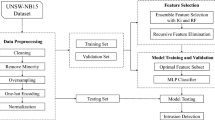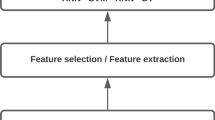Abstract
Automatic modulation recognition plays an important role for many novel computer and communication technologies. Most of the proposed systems can only identify a few kinds of digital signal and/or low order of them. They usually require high levels of signal-to-noise ratio. In this paper, we present a novel hybrid intelligent system that automatically recognizes a variety of digital signals. In this recognizer, a multilayer perceptron neural network with resilient back propagation learning algorithm is proposed as the classifier. For the first time, a combination set of spectral features and higher order moments up to eighth and higher order cumulants up to eighth are proposed as the effective features. Then we have optimized the classifier design by bees algorithm (BA) for selection of the best features that are fed to the classifier. This optimization method is new for this area. Simulation results show that the proposed technique has very high recognition accuracy with seven features selected by BA.


Similar content being viewed by others
References
Sue W, Jefferson LX, Mengchou Z (2008) Real-time modulation classification based on maximum likelihood. IEEE Comm Letters 12:801–803
Swami A, Sadler BM (2000) Hierarchical digital modulation classification using cumulants. IEEE Trans Comm 48:416–429
Donoho D, Huo X (1997) Large-sample modulation classification using Hellinger representation. First IEEE Signal Processing Workshop on Signal processing Advances in Wireless Communications, pp 133–137
Nandi AK, Azzouz EE (1998) Algorithms for automatic modulation recognition of communication signals. IEEE Trans Comm 46, no.4:431–436
Spooner CM (1995) Classification of cochannel communication signals using cyclic cumulants. Proceedings of ASILOMAR, pp 531–536
Dobre OA, Bar-Ness Y, Su W (2004) Robust QAM modulation classification algorithm based on cyclic cumulants. Proceedings of WCNC, pp 745–748
Lopatka J, Macrej P (2000) Automatic modulation classification using statistical moments and a fuzzy classifier. Proceedings of ICSP, pp 121–127
Cai Q, Wei P, Xiao X (2004) A digital modulation recognition method. Proceedings of ICASSP, pp 863–866
Ho KC, Prokopiw W, Chan YT (2000) Modulation identification of digital signals by wavelet transform. Proc IEE Radar Sonar Navig 147(4):169–176
Wu Z, Wang X, Ren G (2005) Automatic digital modulation recognition based on art2a-dwnn. Proceedings of ISNN, pp 381–386
Mobasseri BG (2000) Digital modulation classification using constellation shape. Signal Process 80:251–277
Hsue SZ, Soliman SS (1990) Automatic modulation classification using zero-crossing. IEE Proc Radar Sonar and Navigation 137:459–464
Deng H, Doroslovacki M, Mustafa H, Jinghao X, Sunggy K (2002) Automatic digital modulation classification using instantaneous features. Proc ICASSP 4:IV4168
Zhao Y, Ren G, Wang X, Wu Z, Gu X (2003) Automatic digital modulation recognition using artificial neural networks. Proceedings of the International Conference on Neural Networks and Signal Processing, pp 257–260
Sehier CLP (1993) Automatic modulation recognition with a hierarchical neural network. Proceedings of MILCOM, pp 111–115
Mingquan L, Xianci X, Lemin L (1998) AR modeling based features extraction for multiple signals for modulation recognition. Signal Processing Proceedings, Fourth International Conference, Beijing, vol 2, pp 1385–1388
Avci E, Hanbay D, Varol A (2007) An expert discrete wavelet adaptive network based fuzzy inference system for digital modulation recognition. Expert Sys with Applications 33:582–589
Shermeh AEZ, Ghaderi R (2008) An intelligent system for classification of the communication formats using PSO. Informatica 32:213–218
Pham DT, Ghanbarzadeh A, Koc E, Otri S, Rahim S, Zaidi S (2006) The bees algorithm, a novel tool for complex optimization problems. Proceedings of the 2nd International Virtual Conference on Intelligent Production Machines and Systems (IPROMS 2006)
Proakis JG (2001) Digital communications. McGraw-Hill, New York
Nikias CL, Petropulu AP (1993) Higher-order spectra analysis: a nonlinear signal processing framework. PTR Prentice-Hall, Englewood Cliffs
Haykin S (1999) Neural networks: a comprehensive foundation. MacMillan, New York
Riedmiller M (1994) Advanced supervised learning in MLPs. Comput Stand Interfaces 16:265–278
Kohavi R, John GH (1997) Wrappers for feature subset selection. Artificial Intelligence 97:273–324
Tollenaere T (1990) Supersab: fast adaptive bp with good scaling properties. Neural Netw 3:561–573
Author information
Authors and Affiliations
Corresponding author
Rights and permissions
About this article
Cite this article
Shermeh, A.E., Azimi, H. Blind signal-type classification using a novel robust feature subset selection method and neural network classifier. Ann. Telecommun. 65, 625–633 (2010). https://doi.org/10.1007/s12243-010-0180-4
Received:
Accepted:
Published:
Issue Date:
DOI: https://doi.org/10.1007/s12243-010-0180-4




